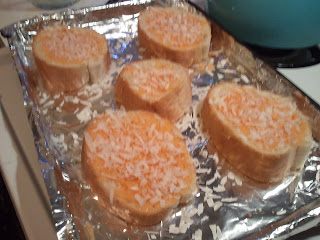My mom loves to cook, and we ate a lot of different foods when I was young. I don't think I really realized how--varied? international? something like that--our diet was until I went to college.
Still, we did have a few staple recipes in frequent rotation. A lot of them were plays on pasta--pasta with tuna fish, clam spaghetti, garlic spaghetti, even, infrequently, spaghetti with meat sauce.
Another one of those staple recipes was fried rice. And for good reason--fried rice is cheap, easy, and makes a lot of food. Mom's version included ground beef as well as a couple of eggs, so it serviced adequately as a main dish. We ate a lot of it, and with gusto.
So it's perhaps surprising that I don't think I've ever made fried rice in the history of my married career.
For one, neither the DDH nor I are big rice eaters. I am stupidly terrible at cooking rice, and after suffering through one crunchy dish too many, the DDH learned to greet rice dishes with trepidation. Rice isn't cheap if you're ruining it (and all the ingredients you add to it) all the time.
For another, though I remember scarfing down huge portions of the dish as a child, I remember fried rice as being too salty, with a slightly weird sour flavor (sorry, Mom), and generally not interesting enough to attempt to recreate.
But since the DDH has flatly refused to acknowledge the awesomeness of Tuna Fish Pasta, and with the impending arrival of someone who will eventually be a teenage boy, I've decided I need to revisit some of those cheap-and-easy childhood staples.
Then I ended up with a whole bunch of free cooked rice, and I knew that it was time to tackle fried rice. I could attempt the recipe without risking poorly-cooked rice. And since I didn't need to spend forty minutes cooking rice, I could actually get dinner on the table on a Monday evening when I had a Zumba class quickly followed by a church meeting.
I tweaked my mom's recipes in a few ways.
First, I eliminated the ground beef, not because I don't like ground beef in fried rice but because I didn't have any defrosted and didn't really have time for the extra step of cooking it anyway. Eliminating that and the accompanying beef broth turned this into a vegetarian recipe, but I'll report back with a meaty version one of these days.
Second, having eliminated the beef, I needed to punch up the protein somehow. The bites of scrambled egg are my favorite part of fried rice anyway, so it was a no-brainer to increase the egg in the recipe.
Third, I cut back on the soy sauce, since I remembered it being too salty (though cutting the beef broth probably also saved some sodium).
And finally, I added some other sauces and spices to give it a more interesting flavor. Adding sambal oolek gives it a touch of bite--not what I think of as a lot, but you do taste it. In retrospect, it's possible that Mom's fried rice was mild-flavored because we were kids. Specifically, I'm the kid who liked everything bland and hated spicy foods. So, umm, keep in mind that it's probably entirely my fault her recipe wasn't perfect to begin with. I bet when she makes it for just herself and Dad it's deliciously seasoned. Ahem.
 |
| Vegetarian Fried Rice |
Vegetarian Fried Rice
Adapted from my mom's recipe.
As I mentioned, I started with pre-cooked rice leftover from an office lunch. If you did not have the opportunity to rescue rice destined for the trash can, you should cook it first. Cook 1 1/2 cups rice according to package directions (to yield 3 cups rice, cooked). Set it aside and allow to cool. If you're really on top of things, you could cook the rice over the weekend and refrigerate it so it's ready to go for a fast weeknight dinner. I have never actually been this on top of things, but I pretend I am all the time.
 |
| Rice courtesy P.F. Chang's and my boss. |
Chop 1 medium onion and 4-5 cloves garlic so they're ready to go. I speed-demoned them in the food processor:
 |
 |
 |
to:
 |
| They never knew what hit them. |
 |
Add the onion and garlic
 |
and sautee until onion is translucent.
 |
| Transluscent onion. |
 |
| I cut the bag open with scissors and still managed to spill veggies all over the counter. |
 |
 |
 |
| Eggs. |
 |
 |
| Or more, if you like soy sauce. |
 |
 |
 |
Add your scrambled egg
 |
 |
Quick, easy, cheap, tasty--it even tastes just as good the next day. Huzzah for fried rice!
 |
| Vegetarian Fried Rice |











































